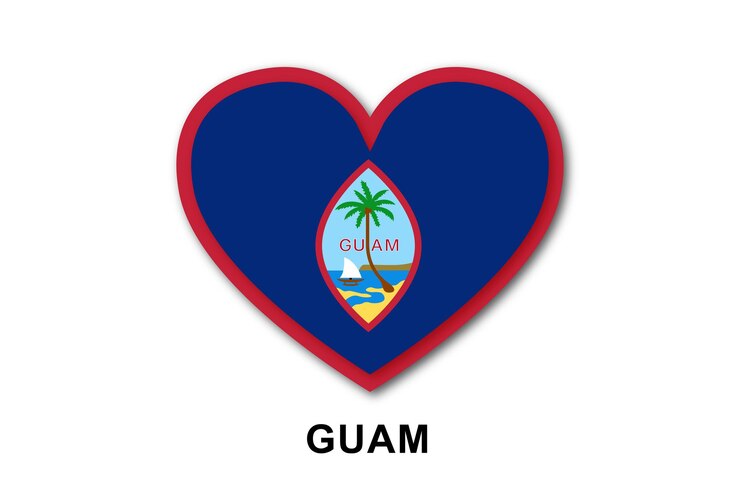The Guam Flag: Symbolism and Significance
The Guam flag is not just a piece of fabric; it embodies the rich history, culture, and identity of the people of Guam. As the only U.S. territory located in the Pacific, Guam’s flag represents its unique blend of indigenous Chamorro heritage and its connection to the United States. In this article, we will explore the symbolism behind the Guam flag, its historical context, and the importance of this emblem for the people of Guam today.
The Design of the Guam Flag
The Guam flag features a distinctive design that sets it apart from other flags. The flag’s primary colors are deep blue and red, with a central emblem that holds significant meaning.
Colors of the Flag
- Blue: The deep blue color of the flag symbolizes the vast ocean surrounding the island of Guam. It represents peace, loyalty, and the relationship of the Chamorro people with the sea, which has historically been their source of sustenance and livelihood.
- Red: The red color represents the blood shed by the Chamorro people during their struggles for survival and sovereignty. It symbolizes courage, strength, and the enduring spirit of the people of Guam.
The Seal of Guam
At the center of the flag is the seal of Guam, which is framed by a maroon border. The seal features a coconut tree, a symbol of the tropical nature of the island, along with a flying proa (a traditional Chamorro canoe), which represents the island’s maritime heritage. The proa is a reminder of the ancient Chamorro navigators who traveled vast distances across the Pacific Ocean.
The seal also depicts a picturesque view of the island, highlighting the importance of Guam’s natural beauty and resources. The words “Guam” and “U.S.A.” are prominently displayed, emphasizing the island’s status as a U.S. territory and its cultural identity.
Historical Context of the Guam Flag
The current design of the Guam flag was officially adopted on February 9, 1948. However, the history of flags representing Guam dates back much further, reflecting the island’s colonial past and its journey toward self-determination.
Early Flags of Guam
Before the current flag was adopted, Guam was under various colonial powers, including Spain and the United States. Each period brought different symbols and representations.
- Spanish Colonization: During Spanish rule (1565-1898), the flag of Spain was used, which did not represent the island’s unique identity. The Chamorro people were largely marginalized during this time, and their culture was suppressed.
- American Control: Following the Spanish-American War in 1898, Guam became a U.S. territory. The American flag flew over the island, symbolizing a new era but still lacking recognition of Guam’s indigenous identity.
Adoption of the Current Flag
The Guam flag as we know it was designed to assert the island’s unique identity while acknowledging its relationship with the United States. The adoption of the flag in 1948 coincided with the island’s post-war recovery and the push for greater self-governance. The flag serves as a unifying symbol for the Chamorro people, reflecting their resilience and cultural pride.
The Importance of the Guam Flag Today
The Guam flag is more than just a symbol; it represents the identity, history, and aspirations of the people of Guam. Its significance extends beyond mere aesthetics, embodying the collective memory of the island’s past and its vision for the future.
Cultural Significance
The Guam flag is a source of pride for the Chamorro people. It is prominently displayed during national holidays, cultural celebrations, and events honoring the island’s history. The flag serves as a reminder of the struggles faced by the Chamorro people and their commitment to preserving their culture.
Political Representation
As a U.S. territory, Guam has a unique political status. The flag represents the island’s ongoing quest for greater self-determination and political recognition. The Chamorro people have long advocated for political rights and representation, and the flag serves as a powerful symbol of their aspirations for a more autonomous future.
Education and Awareness
The Guam fla’g is also an educational tool. It is often used in schools to teach students about their heritage, history, and the importance of cultural identity. Understanding the symbolism behind the flag fosters a sense of belonging and pride among the younger generations.
The Guam Flag in International Context
While the Guam flag is primarily a symbol of local identity, it also represents the island’s place in the global community. As a U.S. territory, Guam plays a strategic role in U.S. military operations in the Pacific. The flag is displayed at various international events, showcasing Guam’s unique identity and contributions.
Participation in Global Events
Guam has participated in various international sporting events, cultural exchanges, and diplomatic gatherings. During these occasions, the Guam fla’g is prominently displayed, allowing the island to showcase its heritage and promote its culture to the world.
Solidarity with Other Territories
The Guam fla’g also symbolizes solidarity with other U.S. territories and indigenous communities around the world. It serves as a reminder of the shared struggles for self-determination and recognition faced by many marginalized communities. The flag unites the voices of these groups in their quest for justice and equality.
Conclusion
The Guam flag is a powerful symbol that encapsulates the rich history, culture, and aspirations of the people of Guam. Its design, colors, and central emblem reflect the island’s unique identity and connection to both its indigenous roots and its status as a U.S. territory. As the people of Guam continue to navigate the complexities of their political status and cultural heritage, the flag remains a unifying symbol of pride, resilience, and hope for a brighter future.
FAQs
What do the colors of the Guam flag represent?
The blue color represents the ocean surrounding the island, symbolizing peace and loyalty, while the red represents the blood shed by the Chamorro people during their struggles.
When was the Guam flag officially adopted?
The Guam fla’g was officially adopted on February 9, 1948.
What is the significance of the seal on the Guam flag?
The seal features a coconut tree and a flying proa, symbolizing Guam’s natural beauty and maritime heritage. It emphasizes the island’s identity and connection to the sea.
How is the Guam flag used in cultural celebrations?
The Guam fla’g is prominently displayed during national holidays, cultural events, and celebrations, serving as a source of pride for the Chamorro people.
Why is the Guam flag important for political representation?
The flag symbolizes the ongoing quest for greater self-determination and political recognition for the people of Guam as a U.S. territory.







